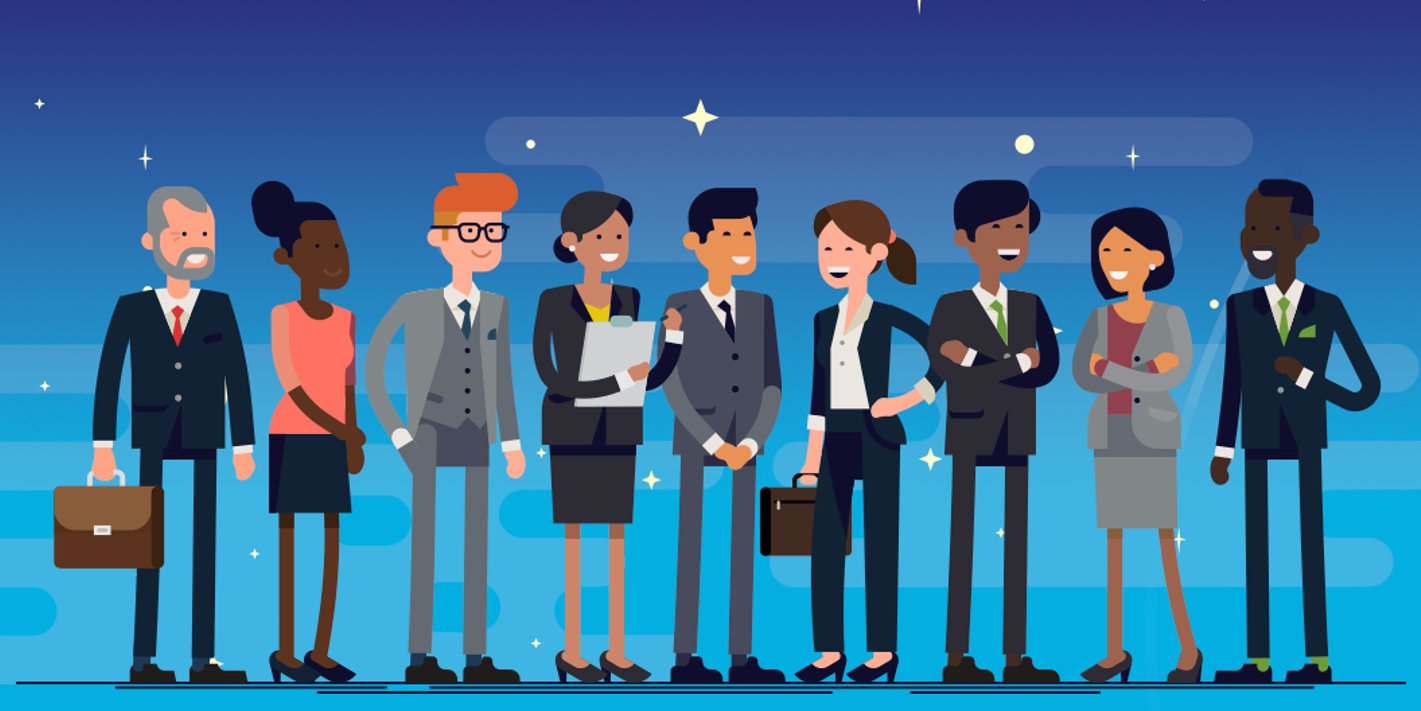Why Your Organization Is Not Benefiting From Diversity
And How To Fix It
The best interview advice I ever received was “be yourself.” This simple yet powerful suggestion … seems to be today’s reigning sentiment, shared by some of the most successful organizations in the world.
Вернуться на Главную

While “being you” might seem like an obvious undertaking, it is, in reality, transformational for individuals and corporations that truly honor individuality. After coaching others on the idea for years and personally experiencing the benefits, I find it reaffirming to see major organizations now championing the movement. When speaking of a drive to encourage candidates and people who work for you to be themselves, I am essentially referring to the notion of creating and fostering a culture of belonging—in more traditional terms, one that is diverse and inclusive.
Faced with shifting national demographics, five distinct generations in the workplace and one of the most competitive talent landscapes in the history of the world, many organizations are scrambling to redefine themselves. As desired brands seek to distinguish themselves, they must concern themselves with a values-based commitment to creating cultures where everyone feels like they belong. “The next-generation workforce cares deeply about where and how and with whom they work, the values and reputation of their employers and the character of their leaders,” says Taffye Benson Clayton, Ph.D., Auburn University’s associate provost and vice president for inclusion and diversity.
However, hiring people of different cultural backgrounds is not necessarily the road to a diverse culture. Hiring an ethnic- or gender-diverse candidate does not make your organization one of belonging. In fact, in many cases recruiting and hiring managers unconsciously target diversity candidates who act like the majority rather than seeking to bring true differences to their organization.
Hiring people who think and act like you do is comfortable: you know what they look and sound like, and uniformity feels easier to manage. However, doing so stifles diversity, a sense of belonging and innovation. When people who all think alike come together, they consistently dream up similar solutions. High levels of innovation only happen when you leverage the insights of people who see the world differently.
Hiring, recognizing and promoting people for who they are—their unique differences—and celebrating their exemplary work represents a competitive advantage for organizations of all sizes and types.
Adopting A “Be You” Mindset
While humans have a primal need to feel included, the differences among us often drive us apart. Despite the fact that we share a common humanity, we feel more comfortable with those who are most like us. This affinity bias impacts the way we look, act and think, as well as our beliefs and cultural backgrounds.
In her TEDxDelrayBeach talk, “Inclusion, Exclusion, Illusion and Collusion,” Helen Turnbull discusses the fact that our “in-group” (those we feel closest to) is often—not surprisingly—much smaller than our “out-group” (those we feel more removed from). In fact, science has proven that the neuropathways we use to think about ourselves and those in our in-group are the same. However, thoughts about those in our out-group travel different neuropathways, making us most empathetic to those in our in-group and more indifferent to those in our out-group.
Finding, acknowledging and embracing differences is the first step to building a high-performing culture of belonging. Organizational behaviors and values must attract differences, not weed out individuals who don’t fit a uniform mold. Bringing out the best in people and valuing what they bring to the table are goals that must be built into the cerebral architecture of an organization’s leadership.
When organizations focus on individuals rather than on general group sentiment, they become sensitive to the needs of everyone—and they naturally make others feel a sense of belonging, attracting and retaining diverse talent.
The U.K.-based restaurant chain Wagamama offers a shining example of a culture that exudes individualism, belonging and diversity. At the restaurant in Reading, England, my family and I dined at a communal table and were served by a highly diverse waitstaff who were female, male, black, white, Hispanic, Asian, Indian, blue haired, green haired, tattooed or body pierced, as well as by those most comfortable in conservative attire.
At the very top of Wagamama’s career page are the words “be you.” That mantra is core to Wagamama’s business success and culture. The organization asks team members not to bring their Wagamama face to work. Wagamama’s leaders are more interested in the faces of those they employ.
The successful noodle restaurant does not want employees who fit into its culture; instead, Wagamama wants the diversity of the people it hires to create, live and evolve the company’s culture. As a result, the culture is a living quilt of diversity, and every new addition makes it more colorful, stronger and unique. Wagamama’s diversity creates belonging, and its culture of belonging drives its diversity.
As at Wagamama, a “be you” mindset has made Johnson & Johnson and Ernst & Young (EY) two of the most diverse companies in the world. They ranked number one on the 2018 and 2017 DiversityInc list, respectively.
At Johnson & Johnson, Chief Diversity and Inclusion Officer Wanda Bryant Hope notes,
Our vision for Diversity & Inclusion at Johnson & Johnson is: Be Yourself, Change the World. We strive for that every day by embedding D&I into the way we do business – enabling everyone to feel they belong and perform at their best. This is how we foster the innovations that are the foundation of our success.»
Karyn Twaronite, EY’s global and Americas diversity & inclusiveness officer, says,
We believe building a better working world starts with fostering a diverse and inclusive culture. To realize the business benefits of inclusion, all of our people must feel a strong sense of belonging. Belonging is the key to ensuring that our people feel engaged, valued and free to be themselves.”
Building Belonging Into Your Organization’s Cerebral Architecture
Belonging needs to be part of an organization’s intellectual and operational fabric, not a program driven solely by workforce diversity statistics. Belonging emerges from inclusive behavior, including recruiting, compensation, benefits and training and development practices. Taking time to understand who people are, what they believe and how they see the world around them is critically important.
JPMorgan Chase has developed a robust talent pipeline through its Autism at Work program by opening the door to a highly educated, highly capable and detail-oriented sector of talent that is 80 to 90% unemployed.
«I firmly believe that companies could always benefit from having employees who see things in an unconventional way, which is something to remember any time an individual on the spectrum is seeking a job,» explains James Mahoney, executive director and Head of Autism at Work for JPMorgan Chase.
Acknowledging differences can be uncomfortable, especially when addressing prejudice, discrimination and racism. But uncomfortable conversations can turn positive when there is a focus on solutions rather than blame.
Inclusion in the workplace plays an important role in recruiting the best talent, improving performance and building a company’s brand. While organizations have made significant progress in building a diverse workforce, it does not necessarily lead to an inclusive work environment. A truly inclusive environment can’t be built by simply changing processes and workflows—it’s about changing how people build relationships,” says Stephen Tavares, Heidrick & Struggles partner.
Cultivating A Diverse Talent Pipeline
Based on her 20-plus years in the field, Auburn’s Taffye Benson Clayton advises that business leaders and diversity and inclusion professionals work side by side to foster engagement opportunities that support the recruitment, retention and development of a diverse workforce. This kind of engagement goes beyond sponsorship, and calls for more collaborative involvement in campus inclusion and diversity programs, conferences, student-led events and professional learning, mentoring, coaching and development experiences. Universities and corporations should create blueprints that allow both to benefit from similar diversity and inclusion educational and organizational learning initiatives while building diverse talent pools.
Collaborations between university and corporate chief diversity officers and chief learning officers could include hosting of cross-sector knowledge-sharing retreats or conferences (such as Auburn University’s 2018 Diversity Best Practices Conference); coauthoring of white papers and journal articles highlighting business and higher education advances in diversity and inclusion research and science; and the co-design of diversity and inclusion learning tools, educational modules and global immersion experiences designed to equip students/future professionals with the cultural and emotional intelligence skills needed to lead in an increasingly diverse society and global economy.
The capacity for business enterprise to partner with higher education is unlimited, but the meaning and purpose of these relationships has to be clearly articulated. Strategies to advance cultures of belonging and diversity on college campuses can certainly be translated for application in business organizations, and vice versa, resulting in opportunities for shared learning, knowledge development, continuous improvement and enhanced talent pipelines.
Leading A Culture Of Belonging
Organizations recognized for their highly diverse cultures have values and strategies that support their diversity and inclusion efforts and that are linked to business growth and operational capabilities. Cross-cultural, cross-gender, cross-generational, cross-functional, cross-segment and cross-region mentoring; diversity councils; employee resource groups; and communities of shared interest are just a few of the foundational elements that exist in such celebrated organizations. However, holding leaders accountable for equitably mentoring, recruiting, sponsoring and advancing talent, together with empowering people to have potentially uncomfortable conversations about gender, race and disabilities, is what accelerates companies like Kaiser Permanente to achieve the number-two spot on last year’s DiversityInc list.
DiversityInc reports that more than 60% of Kaiser Permanente’s total workforce are members of racial, ethnic or cultural minorities, and more than 73% are women. In the highest executive medical group at the organization, 50% are women. The Chairman and CEO personally signs off on executive compensation tied to all diversity efforts and metrics, including supplier diversity.
Johnson & Johnson, ranked number one on the DiversityInc list, has a leadership vision that sees a world in which every person uses their unique experiences and backgrounds to spark solutions that create a better, healthier world.
Academics agree.
Approaching diversity and inclusion as core values positions them as a strategic priority. The imperative of diversity must be authentically embedded into an organization’s business strategy and culture, its leaders’ characters and its employees’ mindsets,” Auburn’s Taffye Benson Clayton concludes.
Leaders must possess emotional and cultural intelligence to navigate today’s complex landscape of diversity in generations, racial and ethnic backgrounds, gender, sexual orientation, gender identity, disability, national origin, religion, intellectual perspectives and political viewpoints. They must also be skilled at operationalizing a sense of belonging into all functions of their business—making it distinguishable, measurable, understandable and observable. The #MeToo and #TimesUp movements have raised a red flag for organizations that must root out hostile and harassing behavior before they can hope to ensure environments in which all people feel valued and included.
The Solution Starts With You
Companies don’t have diversity problems, they have people problems. We cannot change our companies or communities without changing ourselves, and that starts with recognizing and confronting our unconscious bias,” explains diversity consultant, speaker and author, Risha D. Grant.
Grant’s perspective is front and center these days. Starbucks recently let go of one of its shop managers for allegedly having two black men arrested for waiting at a table without making a purchase. In response, Starbucks’ CEO Kevin Johnson will close more than 8,000 company-owned locations and its corporate offices on May 29 to conduct training “designed to address implicit bias, promote conscious inclusion, prevent discrimination and ensure everyone inside a Starbucks store feels safe and welcome.” The two men settled with the city of Philadelphia for $1 each, plus a promise from officials to fund a $200,000 school program for young entrepreneurs. Starbucks also invited the men to complete their undergraduate degrees through Arizona State University in the company’s tuition-paid online education program.
In a statement, the two men said, “We all recognize the importance of communication about differences and solutions, and that we will be measured by our action, not words.”
PwC (ranked number four on DiversityInc 2017) requires all new hires and newly promoted employees to attend in-house training that includes tools designed to lessen negative and unconscious influences.
Grant sees unconscious bias as an unrecognizable part of our upbringing, usually introduced to us by those we love—and, most of the time, the bias is unconscious on their part as well.
In order to understand and overcome your unconscious bias and promote conscious inclusion, Grant prescribes three steps:
- Think about who makes you uncomfortable and why;
- Say your biases aloud to yourself, acknowledge and own them; and
- Intentionally seek out and form authentic relationships with those whom you recognize you have a bias against.
“Nine times out of ten, if you don’t like someone, you will realize that it has more to do with their personality versus anything about their diversity,” Grant concludes.
Helen Turnbull asks people to think about where their blind spots (their unconscious biases) are and how they can be intentional about widening their in-groups. She encourages people to pay attention and adopt a growth mindset when it comes to their interactions with others. Instead of closing your mind to the differences of others, focus on what you can learn from them to enhance your own personal growth and fulfillment.
Ultimately, listening to others, working together and respecting others for who they are and the unique differences they bring to a business and culture are keys to creating a diverse organization where everyone feels they belong.



































